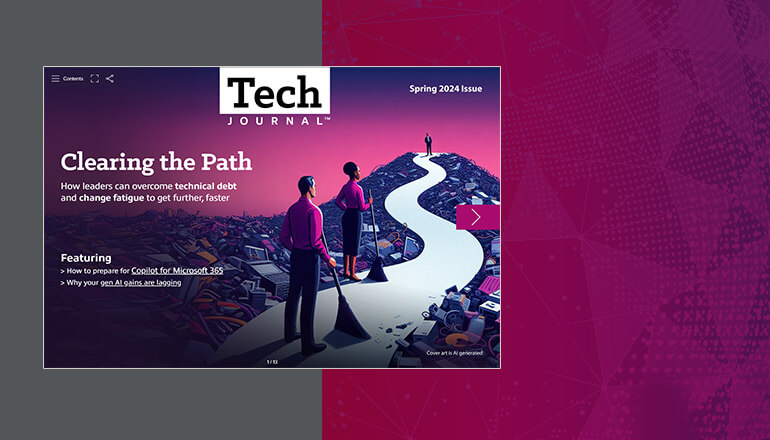Tech Journal The Top 4 Benefits of Collaboration Workspaces
By Paul Harrold / 18 Sep 2019 / Topics: Collaboration

When you envision a meeting space, do you see a conference table with a phone, a tangle of cables, an overhead projector with a pull-down screen and a white board on the wall with dry erase pens? If your answer is yes, you aren’t alone.
If it seems that meeting spaces have remained unchanged since forever, you’d be right. It makes sense. If your team needs to discuss something or work together closely, you would probably use a traditional meeting room with the clutter of hardware inside of it.
Times have changed, and so have our collaboration needs.
That’s why many enterprises are shifting from boardrooms with outdated technology to stimulating collaborative workspaces, complete with the latest hardware and software technology.
Addressing modern teamwork needs
Enterprises worldwide are looking for better collaboration solutions. This is evidenced by increased demand and growth in the collaboration space. Gartner, in their 2018 Market Guide for Workstream Collaboration, predicts that the collaboration solutions market will reach $4.9 billion by 2021.
They also note that by 2022, 70 percent of teams will primarily use collaboration tools to get their daily work done. Even today, 4K displays with built-in microphones and speakers, video conferencing software, wide-angle cameras and wireless casting technology have made it possible for teams to instantly collaborate in person or remotely. Paired with cloud storage and productivity apps, teams can save and share whiteboard sessions, recordings and documents to a central location for seamless collaboration.
Understanding the collaboration workspace
A collaborative workspace is a room or space with audio and video tools where teams can go to work on the same task at the same time, whether they are in the same office or working remotely. With a collaborative workspace, teams can get together to brainstorm, hold working sessions and do anything else that requires teamwork.
In a collaborative workspace, there are more capabilities and options available than in a traditional meeting room. Matt Eschenfelder, Senior Collaboration Engineer at Insight, has stayed on top of the trends and changes in the collaboration landscape: “It doesn’t require an IT administrator anymore to come in and set up a video conference or local meeting. We now have the audio and video capabilities that let users set up a meeting quickly and on the fly.” Additionally, advancements in hardware and software and their ease of use have made it possible to turn virtually any space into a collaborative workspace.
What collaboration workspaces look like
Three of the more common collaborative workspaces today are personal collaborative workspaces, huddle rooms and executive conference workspaces.
A personal collaborative workspace could be a small office space or home office, equipped with an audio and video phone to join a group meeting, as well as a laptop for real-time editing and team brainstorming.
A huddle space is a larger, more inviting space made to fit a group of three to five. It has a table, a few chairs, a large touch screen device and a camera to connect with remote workers.
An executive conference workspace is typically the size of a traditional board room, but has multiple displays and an interactive system to control multiple sources, PCs, cameras, microphones, and even lights and blinds. Executive conference spaces have all the bells and whistles, capable of easily running meetings with a large team on-site while also engaging remote workers.
The benefits of collaboration workspaces
Small businesses to large enterprises are incorporating collaborative workspaces to help their teams, and they’re reaping the benefits. Here are the top four:
- Strengthened team engagement
- Improved meeting efficiency
- Increased collaborative productivity
- Reduced travel costs
Strengthened team engagement
One of the biggest differences between a traditional meeting room and a collaborative workspace is the level of engagement you can achieve. A modern collaborative workspace is equipped with video conferencing hardware and software that makes it easy to share your screen while allowing remote workers to see you and be seen by you. This gives remote workers the feeling of being with you in the room rather than passively participating in an impersonal phone call. Enabling more impactful connections with remote workers is critical, especially given the rise in the popularity of remote collaboration. According to the International Workplace Group (IWG) 2018 workplace survey, 70 percent of professionals now work at least one day outside of the office. Having video capability in this kind of workspace can elevate group collaboration.
Improved meeting efficiency
Collaborative workspaces are made for instant accessibility and ease of use, which makes collaborating at any given time an effortless process. By enabling team members to start or join a video conference call from anywhere, meetings are more efficient. Equipped with user-friendly technology, these spaces effectively remove the geographical and technological barriers to meeting. There’s no substitute for being in the moment during a brainstorm or working session. With collaborative workspaces, all it takes is an internet connection to attend meetings and stay up to date on projects. Long gone are the days of sending the all-too-familiar meeting recaps to absentees. In their place, meeting recordings can be shared for on-demand viewing, and meeting files and documents can be saved to a centralized space dedicated to that single meeting or subject.
Increased collaboration productivity
When collaborative workspaces are designed to be available for team use, productivity increases. According to the 2019 IWG survey, 65 percent of workers agree that businesses that tailor the work environment to address the work function of their teams, they become more productive. By making meetings easier and more accessible from the start, workers feel encouraged to collaborate frequently, and they feel better prepared to focus on their work instead of having to deal with impersonal, often cumbersome, meeting technology. By integrating cloud-based whiteboard apps and productivity tools, collaborative spaces further enable team members to work together simultaneously with virtually no limitations.
Reduced travel cost
Implementing collaborative workspaces can dramatically cut down on travel costs. Without remote-friendly spaces in the office, it’s difficult for office and remote workers to connect to meetings. Remote participants would then have two choices: travel to make the meeting in person or join via the limited dial-in experience. For business-critical meetings, where participation is essential, the option would be to fund the necessary travel. The costs can add up quickly, especially if you have a large company with many remote employees. When you have well-equipped collaborative workspaces, you can mitigate these costs. Says Eschenfelder, “These collaborative workspaces cut back on the travel budget so significantly, we can typically help enterprises fund the workspace buildouts just with the travel costs they are going to save.” With video conferencing hardware and software, your remote employees can connect to meetings without dipping into travel budgets.
Insight helps you create collaboration spaces for successful teamwork.
If you are looking to incorporate collaborative workspaces in your office, Insight's collaboration practice has the experience and solutions your enterprise needs to elevate your collaborative workspaces. With the right digital tools, you can create an engaging and inspiring collaboration space that ignites innovation.











